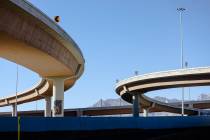Hospitals would band together to aid valley during disasters
Following the 9/11 attacks, subsequent anthrax threats and natural disasters such as Hurricane Katrina, hospitals nationwide beefed up their emergency response plans.
A 2008 study by the U.S. Department of Health and Human Services showed that about 96 percent of hospitals had response plans for chemical releases, natural disasters, epidemics and biological incidents.
Las Vegas is well-prepared for such emergencies, according to hospital officials.
Each hospital has an emergency management committee that meets monthly to discuss and review emergency planning.
Daniel Cross is director of security for St. Rose Dominican Hospitals and chairman of the committee at all three campuses: Siena campus, 3001 St. Rose Parkway, Henderson; Rose de Lima campus, 102 E. Lake Mead Parkway, Henderson; and San Martin campus, 8280 W. Warm Springs Road.
"(The committee) plans for any emergency and how we would mitigate that emergency," Cross said. "It's pretty generic as far as what we prepare for but may be different because of resources."
Every hospital is required to perform at least two emergency drills each year. Most of the valley's hospitals performed earthquake drills this month.
Hospitals also are required to do annual hazard vulnerability assessments to determine what the area's biggest threats are. Earthquakes, shootings and disease outbreaks are the most discussed right now, Cross said.
The biggest issue hospitals face, collectively, Cross said, is that they share most, if not all, of the same suppliers.
"We only have three ways into the valley," Cross said. "If those (roads) are blocked, we're pretty much blocked."
Melinda Case, trauma program manager at Sunrise Hospital & Medical Center, 3186 S. Maryland Parkway, said communication is the most important part of any emergency response.
"That's what we drill for the most," Case said. "That's what is the biggest barrier to any sort of organized rescue or organized disaster preparedness. We brief about that daily on communication issues."
And the lines of communication are ever-expanding with increases in technology.
"We've really come a long way in working together with other local agencies," Case said. "We have steps in place (with other hospitals) so we can act quickly."
Clark County tasked University Medical Center, 1800 W. Charleston Blvd., and e mergency p reparedness c oordinator Ryan Turner to create a cooperative command center in the event of a large-scale disaster.
In such an event, a medical surge area command would be created in d owntown Las Vegas near the county's emergency operations center, with representatives from the valley's 17 hospitals along with military, state and federal officials.
"The hope is when you have all those hospital (officials) sitting there," Turner said, "we can get an instant snapshot when the hospitals are getting those patients. We can divert resources and anticipate the need for resources faster. We can request state or federal resources because we have all the healthcare community working together."
Turner said he and a committee looked at best practices across the country, including hospitals on the Gulf Coast that routinely deal with hurricanes.
"I think that the community should know we're taking this really seriously and hospitals are working together," Turner said. "I think that people may believe we are in competition. We are to an extent, but when a disaster happens, we're all going to work together."
Contact View education reporter Jeff Mosier at jmosier@viewnews.com or 224-5524.























